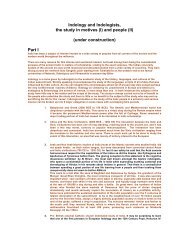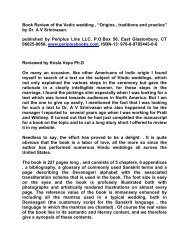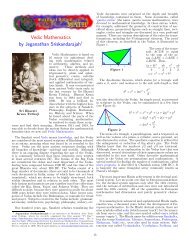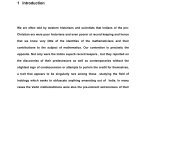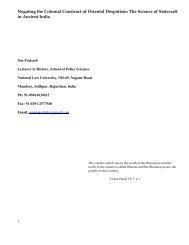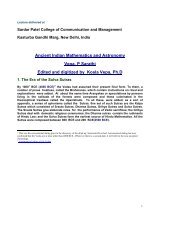The Dhaarmik Traditions - Indic Studies Foundation
The Dhaarmik Traditions - Indic Studies Foundation
The Dhaarmik Traditions - Indic Studies Foundation
You also want an ePaper? Increase the reach of your titles
YUMPU automatically turns print PDFs into web optimized ePapers that Google loves.
133<br />
smrti,ःॆित<br />
that which is remembered, . <strong>The</strong>re are a number of texts that are specifically classed as<br />
smrti and are mostly named after the name of the rshi expounded on the smrti such as<br />
Parashara smrti, Manu smrti and Yajnavalkya smrti<br />
134 Solar Day Solar time is measured by the apparent diurnal motion of the sun, and local noon in solar<br />
time is defined as the moment when the sun is at its highest point in the sky (exactly due<br />
south in the northern hemisphere and due north in the southern hemisphere). <strong>The</strong> time<br />
taken for the sun to return to its highest point is exactly 24 hours, or a solar day.<br />
135 Sramana tradition A śramaṇa is one who performs acts of mortification or austerity. According to the<br />
definition, a being is himself responsible for his own deeds. Salvation, therefore, can be<br />
achieved by anybody irrespective of caste, creed, color or culture. <strong>The</strong> cycle of rebirth to<br />
which every individual is subject is viewed as the cause and substratum of misery. <strong>The</strong><br />
goal of every person is to evolve a way to escape from the cycle of rebirth, namely by<br />
discounting ritual as a means of an emancipation and establishing from the misery of<br />
Saṃsāra, through pious religious activities.. <strong>The</strong> term has been used in the past as a<br />
synonym for the Baudhik tradition<br />
136 Srautasutras Srauta is the adjectival form of Sruti (that which is heard)and is one of the 4 constituent<br />
sutras in the Kalpasutra (see also Sulvasutra)<br />
137 sravanam comes from the same root as sruti. Essentially means learning by listening. Sravanam,<br />
mananam, nididhyasanam is the 3 step process towards Brahma vidya and self<br />
realization<br />
138 sruti, ◌ः◌ॆ◌ुि◌त that which is heard as opposed to that which is remembered (smrti). <strong>The</strong> smrti were<br />
composed by famous rishis and we have<br />
139 Sulvasutras <strong>The</strong> Sulvasutras (or Sulbasutras) or aphorisms of the cord (measurements were made<br />
using a string stretched between 2 pegs). <strong>The</strong> resulting mathematical manipulations<br />
needed to solve the problems of finding areas and volumes of reasonably complex<br />
shapes formed the subject matter of the sulvasutras.<strong>The</strong> Sulvasutras were part of the<br />
Kalpasutra appendices to the Veda.Kalpasutras consisted of Grhyasutras<br />
,Srautasutras,Dharmasuturas and sulvasutras. <strong>The</strong> Kalpasutras in turn are part of<br />
theVedanga (limbsof the Veda)comprising of Chandas (metere).Nirukta(etymology),<br />
Vyakarana Grammar, Jyotisha (Astronomy and astrology) and Kalpasutras.0ne set of<br />
such Sutras are the Kalpa Sutras which consisted of Srauta Sutras, Dharma Sutras,<br />
Grihya Sutras and Sulva Sutras. <strong>The</strong> Srauta Sutras give elaborate rules for the<br />
performance of Vedic sacrifices; the Grihya Sutras deal with domestic religious<br />
ceremonies; the Dharmasutras contain the rudiments of Hindu Law and the Sulva Sutras<br />
form the earliest source of Hindu Mathematics<br />
140



